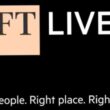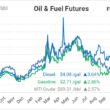Peter Rigby is one of the great survivors among European media company chiefs. He became CEO of what is now Informa Plc in 1989, the year when: Tim Berners-Lee invented the world wide web, Time Inc merged with Warner Brothers, and when Alan Bond’s media-to-brewing group became Australia’s largest ever bankruptcy. It was also the year Rupert Murdoch launched satellite broadcaster Sky TV in the UK with a prediction: “The television set of the future will be, in reality, a telecomputer linked by fibre optic cable to a global cornucopia of programming and nearly infinite libraries of data, education and entertainment, all with full interactivity”.
Rupert Murdoch has thrived in the 23 years since his far-sighted MacTaggart Lecture in Edinburgh. And so has Peter Rigby. He had joined the then International Business Communications (IBC) by way of its acquisition of newsletter and magazine company Stonehart Publications, where he was a rookie Finance Director. That was one of seven diverse acquisitions during 18 heady months for the UK company floated in 1986 by some-time political activist and academic Michael Bell.
In October 1987, the stockmarket was cheering as IBC agreed a £98m deal for newsletter publisher Barham which would triple its value. But the cheering didn’t last. Within days, it was the first Black Monday. It took the shattered market a few more days to realise that Barham was primarily a publisher of – stockmarket tip sheets, notably the Fleet Street Letter.
The IBC shares promptly halved in price. But things got even worse as the reeling company piled up £75m of debt to buy-in 40% of its own shares in a gamble on interest rates that brought it close to collapse. Rigby became CEO, aged 33. His first results in 1990 made hideous reading: a pre-tax loss of £14million, compared with a profit of £13m just two years before. The share price had slumped from £2 to 80p.
Rigby had stumbled into publishing via post-graduate accountancy training at can-maker Metalbox and at Book Club Associates, before joining Stonehart. The following nine years were his baptism of fire in the ways of a public company with crippling bank debt and a ragbag of magazines: Running, British Plastics & Rubber, Direct Response, Banking Technology – and the unwanted stockmarket newsletters. The finance director-turned-CEO started to carve out a strategy for survival, quickly showing he had the temperament for the fight. Three debt restructurings, a rights issue and four years later, he had steered the company through recession, soaring interest rates and back to profitability. Rigby had made it. In April 1994, he euphorically announced an underlying operating profit increase of 22%, re-stated earnings per share up 49% and debt reduced by 80%.
The boy-becomes-man CEO was blinking into the sun as he told analysts with masterly under-statement that “a real obstacle to the group’s future progress and well-being has been removed”. He celebrated the company’s return to financial health with its first dividend for four years. The immediate reward was a 8% jump in share price back to the £2 peak of 1987.
Rigby had arrived and IBC was back. But the really big breakthrough had to wait another four years. LLP (“Lloyd’s of London Press”) the publisher of the 278-year-old shipping daily Lloyd’s List, had been a management buy-out in 1995. It went public in April 1998, led by CEO David Gilbertson. Seven months on, IBC and LLP announced a merger to create a business information group worth £300m with projected profits of more than £30m. The two companies were clearly compatible: niche international information businesses joined-up by conference activities.
The merged company would be called Informa Plc. Peter Rigby became executive chairman and David Gilbertson (who had previously been editor of Lancet, Metal Bulletin and Lloyd’s List) became CEO. The dream team said that Informa generated “only 15% by publishing on the internet or CD-ROM but this is expected to grow rapidly”. Investors were still cheering five years later as 2003 operating profits reached £46m.
In 2003, Informa snapped up the privately-owned PJB Publications (publisher of Scrip and other pharmaceutical industry newsletters) from under the noses of bigger rivals. The £120m deal was the company’s largest (so far), transformed its life sciences portfolio and was characteristic of many subsequent acquisitions: it chose carefully, paid well and pre-emptively reassured its new employees that their jobs were safe. It marked Informa out as a clever acquirer of businesses – and a popular employer. And it was just limbering up.
The following year, Informa broke the mould and struck transformational merger No.2 with STM publisher Taylor & Francis which had celebrated its 200th anniversary by floating on the stock exchange in the year IBC and LLP had merged. They waxed lyrical about: the scope for geographical brand extensions; the crossover demand for information between academic, scientific and business communities; and the ‘well balanced’ portfolio.
The real strength of the 2004 merger could be seen, though, in the sheer scale of the enlarged business which would have 2,500 subscription-based products and services, 2,800 events per year, databases of almost 10million names – and the scope to extend T&F science journals into conferences. The creation of a £500m-turnover company, underpinned by its new partner’s solid subscription revenues – and almost £10m of cost savings – looked like a steal for Informa. The price of a nil-premium merger was merely a cumbersome new name “T & F Informa” – but that prefix wouldn’t last much longer than the former Taylor & Francis CEO who became chairman of the merged company for less than a year. Rigby and Gilbertson then resumed their goal-scoring partnership.
Now they were getting into their stride. In 2005, 12 months after the Taylor & Francis merger, Informa splashed £768m on transformational deal No.3. Irvine Laidlaw had built the grandly-named Institute of International Research (IIR) into the world’s largest conference and training business with revenues of £300m. It was an intriguing deal. Rigby had been stalking IIR for more than 10 years but had found Laidlaw reluctant to talk seriously with a direct competitor. Informa bounced late into the 2005 auction and out-bid the private equity firms who were banking on it.
It was actually the second time Laidlaw had sold to Informa. IBC had first bought IIR in 1980. Then, on the day Laidlaw’s ‘non-compete’contract ended, he simply started the same business again. The euphoric Rigby told investors that the IIR deal had doubled Informa’s database of potential delegates and subscribers. For transformational deal No.3, the pay-off would be measured in new conference activity and databases. But IIR also brought a substantial shift in international earnings with strong businesses in North America and the Middle East. It increased the number of Informa’s worldwide employees from 4,000 to 7,000.
But the IIR acquisition was also the deal that many of Informa’s envious competitors expected to be the ‘bridge too far’ that is the fate of so many acquisitive companies. (In 2005, the once-soaring EMAP magazine group was crashing to earth after its disastrous US acquisition). But investors loved the promised £19m of cost savings and Informa’s increased presence in global growth areas. Even, though, the acquisition would be funded both by borrowings and a rights issue, the share price jumped 6% on the news that Rigby and Gilbertson had done it again.
And again. Two years after what at times sounded to observers like a bumpy digestion of IIR (but proved to be fine, with 2006 operating profit leaping 49% to £219m and margins pushing over 21%), they reached for transformational deal number 4. The winner was Mike Danson, founder of business information and research group Datamonitor. Informa paid £513m – or 27 times forecast 2008 profits and 7 times revenues – for the company which had made its debut 18 years earlier, with a report on the UK frozen food industry.
Investors fretted about the price and also the modest £3m planned for cost savings. Rigby had to make as much as possible of the ways in which Informa could ramp up the earnings of Datamonitor’s products through its international sales network. Although Informa’s overall performance managed to compensate for the undoubted strains of the high-priced deal, it proved to be the high-water mark in more ways than one.
And then the bad news started. In March 2008, eight months after the acquisition of Datamonitor and almost 10 years after the creation of Informa, CEO David Gilbertson quit to join the private equity-backed buyout of EMAP’s business information and events group. Rigby, who had latterly been Informa chairman, again became CEO. For some investors and employees alike, Gilbertson’s departure became an excuse to worry about where the company (which had scarcely put a foot wrong in 10 years) would now be headed. It has been a jittery four years since…
2008: Seemingly promising merger talks with the exhibitions-led United Business Media (UBM) are aborted. The whispers are that Rigby and UBM’s similarly high-rated CEO David Levin can’t agree on who will be boss.
The failed talks renew investor moans about Informa having reportedly turned down a 2006 boom-time 630p bid from Springer scientific group (it is actually believed to have been rejected by Informa non-executive directors against Rigby-Gilbertson advice). But, although the indicative offer did split the board, the £6+ bid never actually materialised. Prolonged Informa negotiations follow with private equity firms but these too collapse without agreement amid reported bids at 450-500p a share. One institutional shareholder says: “I am struggling to see how Informa is acting in my interests. I would rather they were selling the company than trying to buy something.” (Salt in wounds on 16/11/12: the share price is £3.80p; it has seldom reached £4.50 in the six years since that £6.30p bid.)
2009: Furious shareholders slap down Informa for proposing to acquire Springer itself (as Taylor & Francis had tried to do pre-Informa, in 2003). The bid is just a few months after a £242m rights issue to pay down IIR-inflated debt. The timing is made worse by its failure to sell the spluttering US consultancy business Robbins-Gioia after expecting £80m.
2010: Some analysts are getting sceptical. “Frankly, Informa are a bit sub-scale. I wouldn’t rule out acquisitions entirely. The financing for Springer was a bridge too far, although the commercial logic was fine. Informa must show that it can trade its way out of the downturn. They need to be more disciplined, they are impatient. I think Peter Rigby is obviously very ambitious and very driven.”
2012: Eurozone weakness prompts the company to warn that its conference revenues are unlikely to rebound to 2007 levels.
Peter Rigby’s 23 years at the helm of what is a now a £2.3bn company have equipped him to withstand the sniping of fickle shareholders who couldn’t care less that he created Informa from the ruins of IBC. The company in 2012 is certainly something to write home about:
- It is a high-quality and broadly international information provider (75% digital) with revenue split between: academic information, business information, events and training; and between subscriptions (67% of publishing), events and copy sales. 2012 forecast pre-tax profit of £315m on revenue of £1.3bn with cash flow equal to 90%+ of profit.
- It is a robust group comprising three different types of business that work in different ways through the cycle: Academic information which is largely non-cyclical; digital Business information, with substantial capacity for organic growth; and Events which are still growing are are market responsive yet more attractive than the tyranny of advertising (to which Informa is largely unexposed).
- Its 4 transformational deals have been worked hard right across the group. In 1998, Lloyd’s List brought a pioneering digital maritime information service. This is the kernel of much of Informa’s online business information and a model of what publishers everywhere have been seeking to do ever since. The IIR deal, by contrast, provided the impetus for the unrivalled customer database which is used throughout Informa. This centralised management of customer data is very powerful, and the envy of many other information groups. Just ask Reed Elsevier people. IIR people also led the transformation of marketing and financial management across Informa. The expensive Datamonitor model has similarly been applied well within Informa to treble its profitability in the five years since acquisition.
In the year when Pearson’s Marjorie Scardino will be bowing out with investor applause still ringing in her ears, it is worth reflecting on a few things: 1) There have been times in her 15-year reign when deals and strategies have scared the horses. 2) The buoyancy of Pearson now rests on the extent to which the company, while being spread across diverse media and information businesses, is geared to the education market. It is all about timing, and about spreading the risk while choosing a sector, discipline or activity in which the company can afford to become a highly-prized global leader rather than risk being sub-scale in several.
Peter Rigby is, by any measure, an exceptional media business leader. He has been a shrewd strategist and inspirational cheerleader for a fast-growing international group, with eyes all over the detail as well as a great grasp of strategic opportunity. He’s also much more painstaking and patient than he sounds, which is how he sealed those four transformational deals most of which were in the sights of the market’s larger players. He’s great with numbers and with people. That’s how Informa got here. The CEO has always punched well above his weight.
This chirpy, down-to-earth, straight-talking Lancashire man reminds some UK media people of EMAP’s Robin Miller. There might be other points of comparison too. Rigby and Gilbertson were that bumpy mix of talent and experience, quiet and noisy, sceptical and bullish, strategic and opportunistic. It is easy to believe (like EMAP’s Miller and Arculus before them) that when departure time came, each of Informa’s stars thought they still had their best days before them – as solo performers.
Insiders detect a loss of emphasis on organic development and innovation now that David Gilbertson’s role at the top of Informa has (sort of) been taken by the company’s star Finance Director, Adam Walker. So, although it is a long time since Peter Rigby seemed anything like a Finance Director, under-pressure Informa risks becoming a company controlled by two FDs. At a time of slow growth and seemingly limited acquisition fire-power, there is an obvious risk of leaning just a bit too hard on the cost budgets to secure medium-term profitability. Perhaps that is what spooks shareholders in the forecast of four years of flat revenue, expected to last through 2013. Have Peter Rigby and Informa run out of steam?
But Informa still has something of the loose federation of sparky creative companies, with a fair number of fiefdoms that contradict the neat organisational charts. It’s all held together by Rigby. Few senior people ever leave Informa: it’s an award-winning company which commands loyalty and respect among employees at all levels. And the CEO, who dresses up as a clown for family Christmas parties and does charity fun runs in a banana costume, commands huge affection. This is a man who has been enjoying himself and so have most of his people. But life is starting to feel a bit more edgy, and any concerted shareholder pressure for a value break-up could be difficult to manage.
Those who have watched enthralled as Informa has moved mountains and dazzled its peers these past 14 years, hope that economic pressures will not force the company to master the art of cost cutting and short-term profit growth – and squashing the company’s huge talent. Rigby has been a master dealmaker and two familiar targets could yet provide a further stage in Informa’s transformation: UBM’s exhibitions and Informa’s conferences would create a unique world player; and Springer is just made for Informa’s Taylor & Francis. And Reed Elsevier might finally dispose of its world-leading exhibitions group. Any of these major deals would give Informa the kind of ‘concerto’ opportunity that Pearson developed with education. And that would ensure – one day – real justice for Peter Rigby: a Scardino-style exit fanfare, at his chosen time. And who knows how soon that may be?
After completing the IIR deal in 2005, the ultra-fit Rigby said: “I enjoy the work very much but I don’t want to over-stay my welcome. I don’t want, at 60, to be pushed out of the door because I’m past my sell-by date.” So, perhaps, there’s less than four years to go.





By far the best piece ever written on Peter and Informa. Compelling combination of biography, case study and commentary – rich in detail, insight and illustration; packed with warmth; surfacing important threats and opportunities. Should be required reading for the board and shareholders.
Good though the article is there are still ommissions where Informa have made very poorly conceived and executed acqusitions, leading to multi million pound loss making disposals. This aside, the problem for Informa is very firmly the future. Few senior people leaving Informa is a considerable part of that problem. There are some very long standing employees in senior positions who no longer merit those roles. Insiders speak of constant reshuffles in certain divisions, with more focus on covering up ineptitude than developing new products and investing in the ones they have. Some senior people have a history of very questionable decision making and Peter’s key task over the coming months is to assess and refresh the senior team to deliver a company which is fit for the next 10 years rather than a rather flacid target for one of the new wave of acquisitive companies. Peter himself is a warm, inspiring, visionary and charismatic leader – qualities he must demand from his reports.